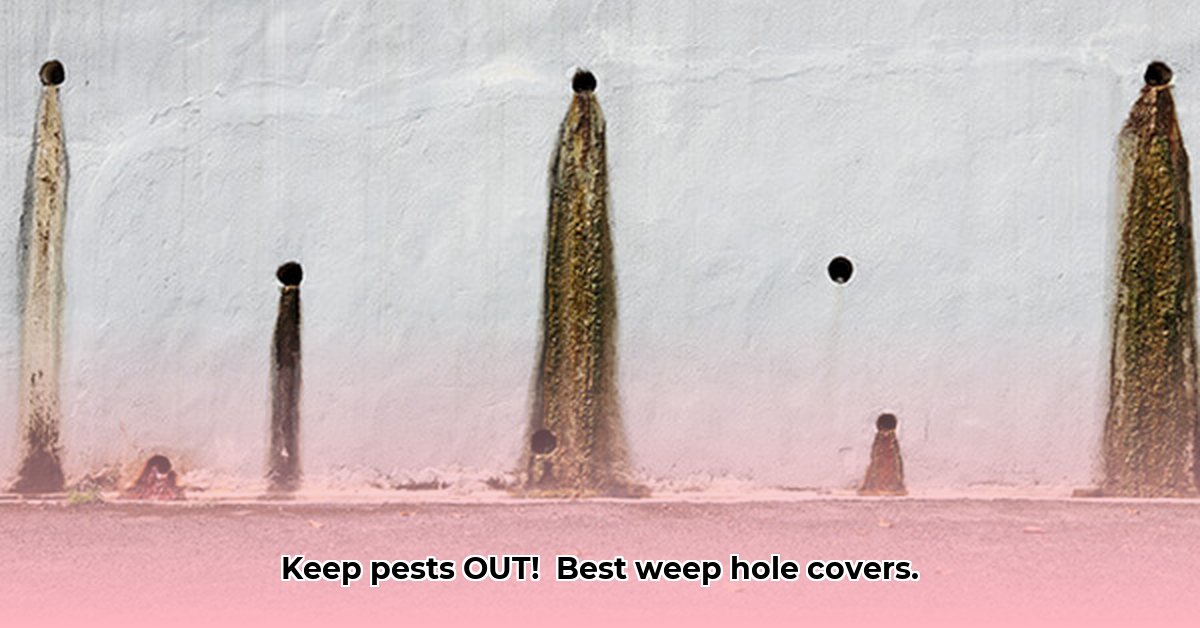Have you ever noticed those small openings in your exterior walls? They’re called weep holes, and they play a vital role in maintaining your home’s structural integrity. Weep holes allow moisture to escape, preventing rot and mold growth within your walls. However, these seemingly harmless holes can also serve as entry points for unwanted pests like insects, rodents, and even snakes. Learn more about comprehensive wall protection at [this helpful resource](https://turthledeep.com/wall-protector/). In this comprehensive guide, we’ll explore everything you need to know about weep hole covers, including their benefits, types, selection criteria, installation tips, and maintenance practices. By the end of this article, you’ll be equipped to safeguard your home from pests and moisture damage effectively and efficiently.
Why You Need Weep Hole Covers: Balancing Ventilation and Pest Control
Learn how weep hole covers protect your home from pests and moisture damage, ensuring long-term structural integrity.
Weep holes are essential for maintaining the health of your home’s walls. They provide ventilation, allowing moisture to escape and preventing the buildup of mold and mildew, which can lead to costly structural damage. However, these openings also create easy access points for pests seeking shelter, food, or water. Without proper protection, your home can become a haven for insects, rodents, and other unwanted critters.
Weep hole covers offer a simple yet effective solution by creating a physical barrier that prevents pests from entering while still allowing for adequate ventilation and moisture drainage. By installing weep hole covers, you can protect your home from costly repairs, health hazards, and structural damage caused by pests and moisture.
Understanding the Risks: Unprotected Weep Holes and Their Consequences
Explore the potential problems associated with unprotected weep holes, emphasizing the importance of maintaining airflow while deterring pests.
Leaving weep holes unprotected can have serious consequences for your home’s structural integrity and your family’s health. Pests can enter through weep holes and build nests within your walls, causing damage to insulation, wiring, and other building materials. Rodents can chew through electrical wires, creating a fire hazard, while insects can contaminate food and spread diseases.
Furthermore, moisture trapped within your walls can lead to mold and mildew growth, which can trigger allergies, asthma, and other respiratory problems. Mold can also damage drywall, wood, and other building materials, leading to costly repairs.
By understanding the risks associated with unprotected weep holes, you can appreciate the importance of installing weep hole covers as a preventative measure.
Types of Weep Hole Covers: Choosing the Right Solution for Your Needs
Compare different types of weep hole covers, including stainless steel mesh, copper mesh, spring-loaded covers, and plastic options, to determine the best fit for your home.
When it comes to weep hole covers, you have several options to choose from, each with its own set of advantages and disadvantages. Here’s a comparison of the most common types of weep hole covers:
- Stainless Steel Mesh: Stainless steel mesh covers are durable, rust-resistant, and effective at keeping out a wide range of pests, including insects and rodents. They provide excellent ventilation and are relatively easy to install. However, they may be more expensive than other options.
- Copper Mesh: Copper mesh covers offer natural pest-repellent properties, as copper is known to deter rodents and insects. They are also durable and rust-resistant, making them a long-lasting solution. However, they may be more expensive than stainless steel mesh covers.
- Spring-Loaded Covers: Spring-loaded covers feature a spring-loaded mechanism that allows for ventilation while blocking larger pests, such as rodents and snakes. They are easy to install and provide a secure fit. However, they may not be as effective against smaller insects.
- Plastic Covers: Plastic covers are the least expensive option, but they offer the least protection and durability. They are prone to cracking and breakage, requiring frequent replacements. They may also not provide adequate ventilation.
Factors to Consider: Choosing the Right Weep Hole Covers for Your Home
Learn how to select the most suitable weep hole covers based on factors such as weep hole size, building material, climate conditions, and pest pressure.
Choosing the right weep hole covers for your home requires careful consideration of several factors, including:
- Weep Hole Size: Measure your weep holes accurately to ensure a proper fit. A poorly-fitting cover will be ineffective at keeping pests out and may impede ventilation.
- Building Material: The type of material your house is made of (e.g., brick, wood siding) can influence your choice of weep hole covers. Some materials may be more susceptible to certain pests or moisture damage than others.
- Climate Conditions: If you live in an area with harsh weather conditions, such as heavy rain or extreme temperatures, choose durable and weather-resistant weep hole covers that can withstand the elements.
- Pest Pressure: If you live in an area with high pest pressure, opt for weep hole covers that provide superior pest protection, such as stainless steel mesh or spring-loaded covers.
Installation Guide: Securing Your Weep Hole Covers for Optimal Protection
Follow step-by-step instructions for installing weep hole covers effectively, ensuring a proper fit and seal to prevent pest entry and maintain airflow.
Installing weep hole covers is a straightforward process that can be completed in a few simple steps:
- Prepare the Weep Holes: Clean the weep holes thoroughly, removing any dirt, debris, or cobwebs.
- Measure and Cut (if necessary): For mesh covers, measure the weep holes and cut the mesh to the appropriate size, leaving a slight overlap.
- Insert the Covers: Carefully insert the covers into the weep holes, ensuring a snug fit.
- Secure the Covers (if necessary): For spring-loaded covers, follow the manufacturer’s instructions to secure the covers in place.
Maintenance Tips: Ensuring Long-Term Performance and Pest Prevention
Discover the best practices for maintaining and inspecting your weep hole covers regularly, preventing issues and ensuring long-term effectiveness.
To ensure the long-term performance of your weep hole covers, it’s essential to inspect them regularly and perform any necessary maintenance. Here are some tips to keep in mind:
- Inspect Regularly: Check your weep hole covers at least twice a year (spring and fall) for any signs of damage, loose fitting, or pest activity.
- Clean Periodically: Clean your weep hole covers periodically to remove any dirt, debris, or cobwebs that may accumulate over time.
- Replace Damaged Covers: Replace any damaged or worn-out covers immediately to maintain optimal protection.
Making the Right Choice: A Summary of Weep Hole Cover Benefits
Recap the key benefits of installing weep hole covers and emphasize the importance of choosing the right type for your home to prevent specific pests.
Investing in weep hole covers is a smart and cost-effective way to protect your home from pests and moisture damage. By choosing the right type of covers for your needs and following the installation and maintenance tips outlined in this guide, you can ensure the long-term health and structural integrity of your home.
Key Takeaways:
- Weep holes are essential for ventilation, but they also provide entry points for pests.
- Weep hole covers offer a simple yet effective solution for preventing pest infestations and moisture damage.
- Choosing the right type of covers depends on factors such as weep hole size, building material, climate conditions, and pest pressure.
- Regular inspection and maintenance are crucial for ensuring the long-term performance of weep hole covers.
- How to Stop Apps From Running in the Background to Boost Your - December 1, 2025
- How To Move Apps On Your Droid For Better Organization - November 30, 2025
- How to Move Apps on Android for Better Organization - November 29, 2025










